By: debbie lynn elias

What better way to honor the opening week of baseball season than with, what I believe, is one of the finest baseball films to come around in a long while – SUGAR. For decades, some of the sports finest players have come from Latin America and particularly, the Dominican Republic – Manny Ramirez, Roberto Clemente, the Alou brothers, Jose Rijos, Manny Nanita, to name a few. They have brought distinction not only to themselves, their teams and the sport, but also to their families and nameless small towns in the regions. Director Ryan Fleck, a lifetime baseball enthusiast (and after speaking with him, dare I say devotee and rapid fan), together with his filmmaking partner Anna Boden, bring us an in depth look at a little known side of the game of baseball told through the eyes of a young player in the Dominican Republic looking for the American Dream, a dream that takes on special meaning for Miguel “Sugar” Santos. And while Miguel Santos may be fiction, the story behind SUGAR is not.
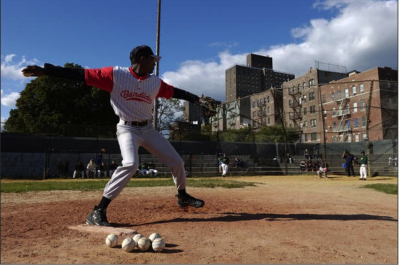
Miguel “Sugar” Santos loves baseball. He eats, sleeps and dreams baseball. By age 16 he is attending the baseball camp in San Pedro De Macoris, one of many throughout the island, most of which are funded and sponsored by teams in America. A star pitcher, Sugar is his family’s “great white hope” for removing them from poverty as everyone prays that he is picked up and signed by a U.S. team. By age 19, it looks as though those hopes and dreams will come true when Sugar is picked up by a minor league team and brought to their farm club in the States for spring training in Arizona.
But for Sugar Santos, and so many others, being signed by a U.S. team presents an entirely new set of problems, starting with the language. Unable to really communicate with his coaches or teammates, Sugar feels a sense of isolation. When he goes to restaurants with the team, not being able to read English and unfamiliar with the food, he orders from the pictures on the menus and in Sugar’s case, end’s up eating french toast at Denny’s for a month. And of course, one of his biggest personal challenges is being a little fish in a big pond with even bigger talent surrounding him. Despite the hardships, however, Sugar shines on the mound and eventually lands a spot with the Single A ballclub in Bridgetown, Iowa – the Swing. And as is custom with the farm clubs, for the season, players are given residence with local families. In Sugar’s case this means the Higgins family, an older devout Christian couple and their granddaughter Anne.

As Sugar continues to dominate the mound on his way to the big leagues, a veteran Dominican player on the team takes Sugar under his wing, showing him the ropes and helping him along, while the Higgins’ unwittingly attempt to Americanize him with church, Mid-West values and lifestyle and even the forging of friendship between their granddaughter and the handsome ball player. But, while life appears good on the outside, inside Miguel Sugar Santos is still lost and alone. And perhaps due to that loneliness and distraction, during a routine play, injuries himself and ends up placed on the disabled list. What happens thereafter leads to a lot of soul searching and reassessment in what truly is the American Dream.
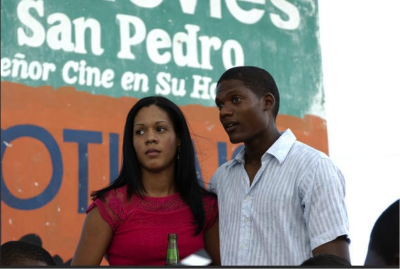
After seeing 500 candidates for the role of Miguel Sugar Santos, and frustration at audition 300 thinking they will never find someone who could act and play ball, Fleck and Boden joyously settled on Algenis Perez Soto for the part. A baseball player in the Dominican, Algenis had never acted before. As a child, his dream was to come to States to play baseball, but that never happened – until now. According to Soto, for him, playing baseball on the big screen is close to playing in the big leagues. But making it on screen almost didn’t happen. As Soto tells it, “I remember that I was in San Pedro. I was playing baseball but I was told before that there was audition for a movie. I was going to go but at the time I realized there was a baseball game at the same time, so as a Dominican, I went to play baseball and I forgot about the audition. Then the places we were when I was playing and where they were having their auditions was very close, so I think they [Fleck and Boden] saw that there were many guys playing baseball and that’s what they were looking for so they went to the field we were playing and invited us to make some auditions. [Boden] asked me if I wanted to be an actor. I say yes, but I wasn’t interested about it. I just said that because I thought it was what she want to hear.. . I thought there was no chance for me but if I’m gonna do this, I’m gonna to learn this [dialogue] and try to do it good.” According to Fleck, Soto took the entire audition process very seriously.

For Fleck and Boden, seeing Soto was a day they will never forget. “We started looking in New York because there is a big Dominican population there but it became pretty apparent pretty quickly that we needed to go down there to find a real Dominican baseball player. We interviewed about 500 people. Algenis was 452. A number we will never forget.”
One would never know that Soto had never stepped in front of a camera before this film. The camera loves him. He has a warmth and natural charm that draws you into the story and the character of Sugar. Peppered with shyness in “American” scenes, Soto’s emotions pour forth with intricate layers of curiosity, innocence and naivete all well hidden at times under the confident bravura of his athletic performance. When pitching, there is a determined earnestness in his stance and on his face that lets you know, this is not acting, this is not pretend. This is real. The game is real. The person is real. From an athletic standpoint and acting standpoint, Soto is a joy to watch.
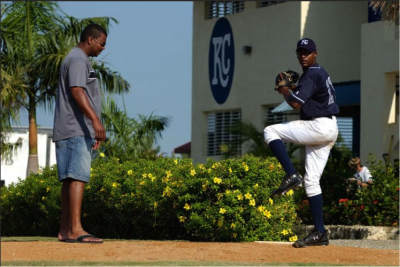
As for Soto he sees much of himself in Sugar Santos. “Me and Miguel have something similar because he is always a hard worker and he is always thinking about his family, to help his family. Everytime that he was trying to play hard, it was because of his friends, but it was because he wanted to have his family get out poverty. I think I am a little bit about that. I am always focused on my family.”
Although a lifelong ballplayer, Soto played second base and shortstop, not a pitcher. “For me to learn to pitch it was a challenge, also like acting. When I was a baseball player since I was 8, 9 years old, I always played shortstop or second baseman and sometimes outfield. But never pitching. It was a first time for me to be a pitcher in this movie. I had 2 months of training with Jose Rijos and he was teaching me the mechanics and how to throw the curve, everything.” Now, he unabashedly admits his best pitch is “The slider. And I have a pretty good fastball.” Watching Soto, as with his acting, one would never know he wasn’t a lifelong pitcher.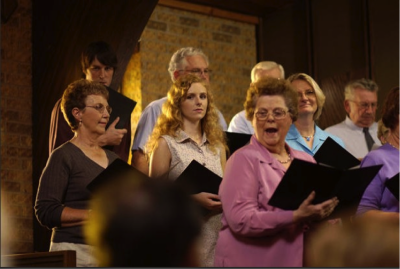
Supporting ballplayers were also gleaned from the Dominican baseball academies – and the 500 player audition process.
Written by Fleck and Boden, the project came about thanks to Fleck’s love of baseball and after reading an article referencing the Dominican academies that every American baseball team has. “I didn’t know those places existed. So I did a little research on line and thought this is an interesting story. . .I became curious about the guys you don’t hear about.” According to Boden, “when we got the idea for the film, we started doing our research which consisted of talking to people who had been through a similar experience in the Dominican Republic, in the Mid West and up in the Bronx. It’s not based on one particular person story. We took details from a lot of different people and try to mesh them together in what we felt was a common experience. ..we were exploring what this person’s life was and what their choices were.” For baseball fans, the result if interesting and educational and technically impeccable. For baseball and film fans alike, the film is refreshing and filled with heart.
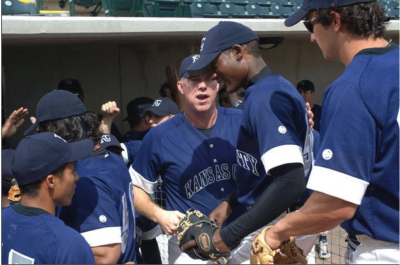
The script has great balance between sports and life’s personal struggle for one man. The characters are full-bodied, well crafted with great attention to detail. Intricacies of the different cultures, locations and lifestyles are visually interwoven like a beautiful tapestry, something which Fleck attributes to each community in which the film was shot and their cooperation not just with the production but with opening their homes and neighborhoods to the art and production departments. In one instance, 800 people were needed to fill a stadium. With a budget that didn’t allow for payment to 800 extras, people in the community came out, filled the stadium and hung in there for a 10 hour day shoot.
Key to this film is its embracing by the baseball community itself. Starting with Day One in the Dominican, Fleck was surprised by how open and welcoming everyone was at the baseball academies giving the filmmakers full access to the players. Thanks to Junior Naboa, former player and now Assistant GM and Director of the Latin American options for the Arizona Diamondbacks, much of the film was shot at their academy, even allowing the filmmakers to paint over the Diamondback logo and replace it with a “KC” logo. Fleck and Boden found a similar openness at the A’s facility in Arizona for spring training. The real ace in the hole, however, was World Series MVP Jose Rijos who served not only as principal technical advisor on the film, but coached Soto and then appears in the film as well.
Beyond the challenges of multiple locations and the need to have help from communities in each location, one of the greatest challenges to making this film was the logistics of the game of baseball. As Boden describes it, “we needed the ball to go in a certain place. We needed the camera to move a certain way and we needed the extras to act a certain way. Getting used to working like that was the biggest obstacle. Our DP [Andrij Parekh] was terrified of the baseball hitting him or a camera. He comes on the field and his grip crew is pushing this huge plexiglass [wall] that is going to go in front of the camera and protect everybody.” Fleck opines, “We were shooting through plexiglass and there was sun and there’s reflection. This is not working.” Ultimately, they were able to get rid of the plexiglass wall and had someone with a mitt protecting the camera leading to some exquisite lensing showcasing not only the beauty and the people of the Dominican Republic, but capturing the heart of baseball.
A hopeful story, a heartwarming story, an entertaining story, this is a not so unique, but very unknown, journey about a boy becoming a man, learning about himself, who eventually makes choices that are not necessarily right or wrong, but the ones the believes are the best for himself, leading him to that sense of community and home that he has sought for so long, all set against that international favorite past time – baseball.
Miguel Sugar Santos – Algenis Perez Soto
Written and Directed by Ryan Fleck and Anna Boden.












